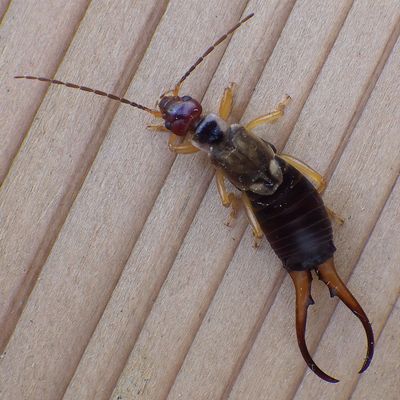Bugging the Northwest: Don’t wig out over earwigs – a pest, an ally and a good mom

Like spiders, earwigs have a bad reputation built largely on fiction. The truth is, they’re not that bad. A nuisance? Yes. A horror story? No.
Surely you’ve heard the lore about earwigs seeking residence inside our ear canals. The earwig name is so bad that even a good PR firm would struggle to fix the insect’s creepy image.
“Its name comes from the Old English words ear wicga, which roughly translates to ‘ear wiggler’ or ‘ear creature,’ ” according to the health care website WebMD. That name, in turn, started the myth that the insect crawls into our ears as we sleep, the site goes on to explain. The myth doesn’t stop with the earwig resting comfortably in our ear canal. Supposedly, it then tunnels into our brains to cause fever and insanity.
The idea that an earwig enters the brain by way of the ear dates back as far as the year 1000, according to the Oxford English Dictionary.
Just about any small insect can blunder into a person’s ear canal, and the idea that earwigs deliberately seek out ears to penetrate is pure superstition, according to entomologist Richard Zack of Washington State University.
“They are called earwigs because the hind wing – which is folded up – looks like an ear,” he said.

Another thing working against earwigs is their looks. Not pretty like butterflies or cute like ladybugs, they are long, dark and unnerving with two intimidating claw-like pincers protruding from their ba ck ends.
“They are ‘prehistoric’ looking in a lot of ways and the large pincers add a certain amount of fear,” Zack said.
Not to worry, though. It’s not as if earwigs use those pincers to dig out ear wax and brain tissue. In fact, the pincers don’t even contain venom.
“The males may use the forceps, called cerci, to fight off other males and they are also used to help the male hold onto the female when they are mating,” he said.
Because earwigs prefer dark places, they crawl into cracks, crevices and curled plant leaves. They also take refuge underneath objects. Lifting a barbecue lid, rock or potted plant and seeing them scuttle can be startling. So, too, can witnessing the insect exit a plug-in hole of an electrical outlet.
Earwigs feed on plant leaves and fruit, which also makes them a nuisance. But they typically penetrate fruit only when it has already sustained damage by other pests such as caterpillars or birds.
While earwigs can damage plants, they can also indirectly protect them. Their preferred food is aphids, a true pest to gardens, trees and apple orchards. They also eat mites, slug eggs and decaying vegetation, which helps with composting.
“Earwigs can be good, bad or pretty much indifferent depending on your view and the circumstances,” Zack said.
The Spokane-based earwig featured in this column photograph is likely the same species you see darting about in your garden or home and is not native to the United States. The European earwig was first documented in Seattle in 1907, according to Iowa State University’s BugGuide.net, and has since spread across the country.
Believe it or not, there’s even something endearing about earwigs. Several published studies show that females make good mothers by tirelessly cleaning and guarding their nest eggs. After the eggs hatch, they remain with their offspring, grooming and feeding them for weeks.